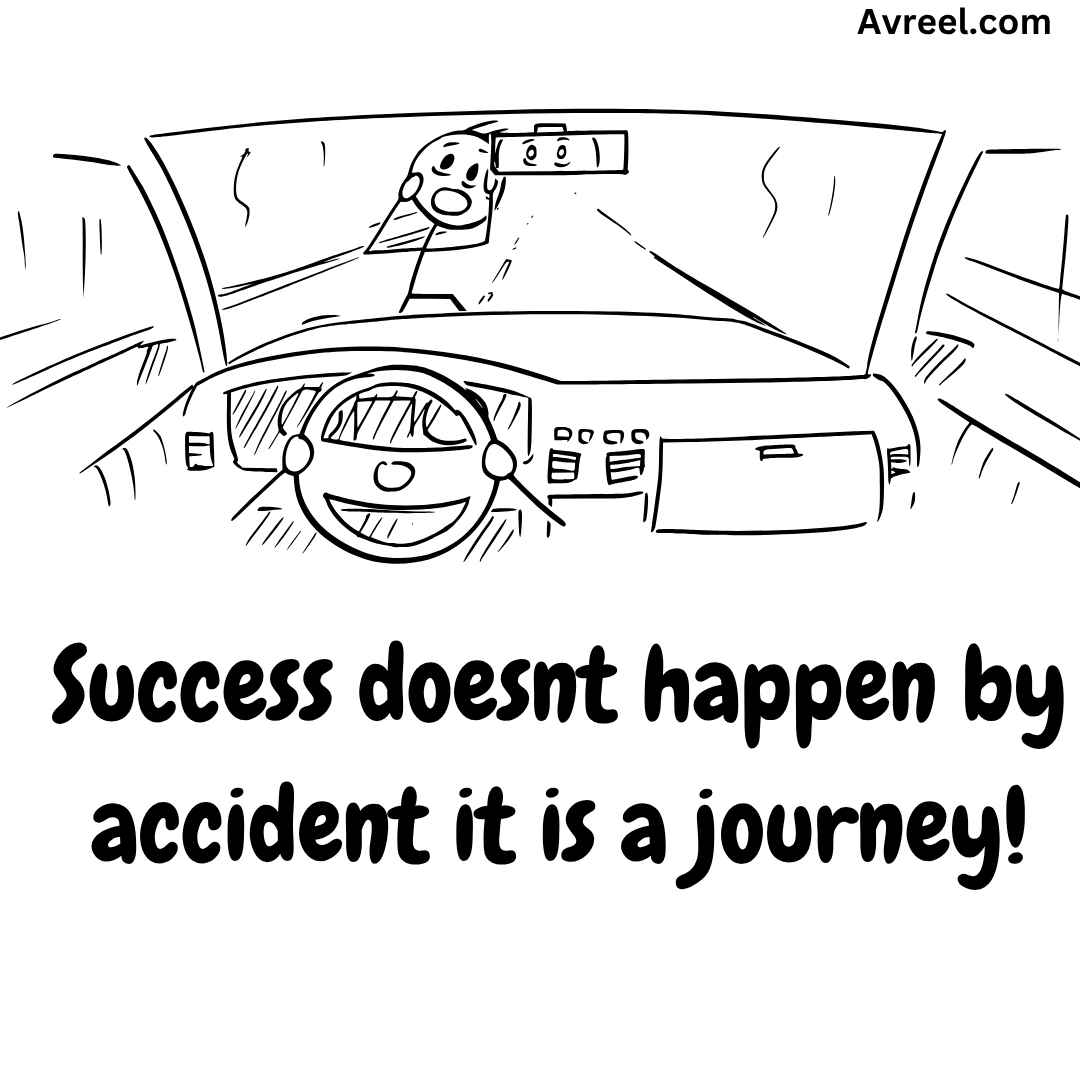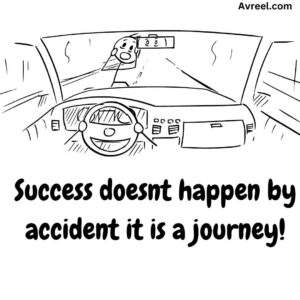Picture this: You’re scrolling through social media and see another “overnight success” story. A 22-year-old just sold their startup for millions.
A content creator went viral and now has book deals. A friend just landed their dream job. Your first thought? “They got lucky.” But what if I told you that luck had nothing to do with it?
The Great Success Myth That’s Holding You Back
We live in a culture obsessed with instant results. We see the finish line but never the starting blocks. We celebrate the victory lap but ignore the years of preparation that made it possible.
“Success doesn’t happen by accident—it is a journey!”
This fundamental truth separates those who achieve lasting success from those who spend their lives waiting for their “lucky break.”
Understanding this shift in perspective isn’t just motivational fluff—it’s the difference between a life of intention and a life of regret.
Do you know the “Accident” Mindset Destroys Dreams?
Yes it does!
The Lottery Ticket Mentality
When you believe success happens by accident, you develop what I call “lottery ticket thinking.” You buy your ticket (start your business, apply for jobs, create content) and then wait for the universe to pick your number.
This passive approach creates a dangerous cycle:
- You take minimal action because you believe results are random
- When nothing happens quickly, you assume you’re “unlucky”
- You give up and try something else, restarting the cycle
- Years pass with no real progress
The Comparison Trap
“Most people see the highlight reel of success but never the behind-the-scenes journey that created it – Look Behind the Scene.”
Social media has weaponized this myth. We see the entrepreneur’s Ferrari but not the five years they lived in their parents’ basement. We see the influencer’s brand deals but not the 1,000 videos that got zero views. We see the promotion announcement but not the nights spent learning new skills after everyone else went home.
The Anatomy of a Success Journey
Phase 1: The Invisible Foundation (Months 1-12)
This is where most people quit because nothing seems to be happening. You’re learning, failing, adjusting, and building skills that no one can see.
“Success is like an iceberg—everyone sees the tip, but the real mass is hidden beneath the surface.”
During this phase:
- Your efforts feel disproportionate to your results
- Friends and family might question your path
- Self-doubt becomes your constant companion
- But you’re building the foundation for everything that follows
Phase 2: The Momentum Shift (Year 2-3)
Small wins start appearing. You begin to see patterns in what works and what doesn’t. Your skills compound, and opportunities start presenting themselves.
“The journey teaches you lessons that no shortcut can provide.”
This is where many people mistake progress for arrival. They get comfortable with modest success and stop pushing. But the real winners understand this is just the beginning.
Phase 3: The Exponential Growth (Year 3+)
This is where the “overnight success” myth gets born. Years of invisible progress suddenly become visible results. But here’s the secret: it only looks sudden to everyone else.
The Journey Mindset is Your Success GPS
Embrace the Process Over the Prize
When you view success as a journey, you stop obsessing over destinations and start optimizing for direction. Every setback becomes data. Every failure becomes education. Every small win becomes fuel.
“The beauty of treating success as a journey is that you’re always moving forward, even when it doesn’t feel like it.”
Build Systems, Not Just Goals
Goals tell you where you want to go. Systems get you there. The journey mindset focuses on building robust systems that create inevitable success:
- Daily Habits: What you do consistently matters more than what you do occasionally
- Learning Systems: How you acquire and apply new knowledge
- Network Building: The relationships you cultivate along the way
- Feedback Loops: How you measure and adjust your approach
Celebrate Milestones, Not Just Endpoints
“Success isn’t a destination you arrive at—it’s a journey you commit to taking every single day.”
When you embrace the journey, you learn to find fulfillment in progress, not just completion. This sustainable approach prevents burnout and keeps you motivated through inevitable challenges.
Let See Real-World Success Journeys & The Truth Behind the Headlines
1. The “Overnight” Tech Founder
- What you see: Is a 25-year-old who just sells his app for $50 million
- This is the journey: He started coding at 12, has built 15 failed apps, worked with and studied successful competitors for years, worked over 80-hour weeks for years building this app.
2. The “Lucky” Content Creator
- What you see: Viral video leads to million-dollar brand deals
- The journey: Posted daily for 4 years, studied analytics obsessively, failed with hundreds of videos, refined their voice through trial and error
3. The “Natural” Sales Leader
- What you see: Promoted to VP after “just” 5 years
- The journey: Read every sales book available, practiced pitches in mirrors, sought mentorship, volunteered for difficult clients others avoided
How to Navigate Your Success Journey
Step 1: Define Your Destination (But Stay Flexible)
Your destination is your North Star, it gives you direction but shouldn’t become a prison.
The most successful people know exactly where they want to go but remain agile about how they get there.
Before you define what success looks like, understand why you want it. Is it financial freedom? Creative fulfillment? Making an impact? Your “why” becomes your compass when the path gets unclear.
Create a detailed picture of what success means to you. Don’t just say “I want to be rich” or “I want to be famous.” Get specific about what your ideal day looks like, how you feel when you wake up, what problems you’re solving, who you’re serving, and what legacy you’re building.
Set quarterly reviews where you honestly assess whether your destination still excites you. Markets change, you change, opportunities evolve. The best journeys adapt to new information while maintaining their core direction.
Think of your destination like a GPS. When you take a wrong turn, it doesn’t judge you, it simply recalculates the route. Your success journey should work the same way.
Step 2: Map Your Milestones
Milestones are the fuel stations on your success highway. They provide motivation, measurement, and momentum when the final destination feels impossibly far away.
Break every major milestone into three phases: what you can accomplish in the next 30 days, what builds on that foundation in 60 days, and what completes this phase of your journey in 90 days. Create two types of milestones: performance milestones that focus on what you’ll achieve like revenue targets, skill certifications, and network size, and process milestones that focus on how you’ll grow through daily habits, learning goals, and relationship building.
Plan your celebrations before you achieve your milestones. This creates positive reinforcement and gives you something to look forward to during difficult periods. Make the celebration proportional to the milestone—completing a course might earn you a nice dinner, while landing a major client might warrant a weekend getaway.
Don’t just measure outcomes; measure the activities that create outcomes. If your goal is to build a successful business, track daily prospecting calls made, skills practiced, content pieces created, network conversations initiated, and market research hours logged.
Step 3: Pack the Right Supplies
Success journeys require careful preparation. You wouldn’t climb Mount Everest without the right gear, and you shouldn’t pursue your dreams without the right resources.
Start with core skills that form your non-negotiable foundation: communication, learning ability, problem-solving, persistence, and adaptability. These universal skills transfer across industries and compound over time. Research the top performers in your field and identify the industry-specific skills that separate them from everyone else, then create a systematic plan to develop those capabilities. Don’t forget to anticipate where your industry is heading and develop skills that will be valuable tomorrow, not just today.
Create a comprehensive learning system that includes books in your field, podcasts that turn commute time into education time, structured courses for complex skills, mentors who’ve walked your path successfully, and conferences that immerse you in your industry’s latest developments. Commit to spending at least 5 hours per week learning, which compounds into 260 hours per year—equivalent to 6+ weeks of full-time education.
Build your network strategically by cultivating relationships with mentors who can guide your journey, peers who can collaborate and support you, proteges you can help, connectors who know everyone, and industry leaders whose visibility can amplify your message. Don’t network for what you can get—network for what you can give. Share insights, make introductions, offer help, and provide value before asking for anything in return.
Plan your resources carefully. Financial resources should include an emergency fund, investment capital for opportunities, and budgets for education, tools, and marketing. Time resources require protected blocks for high-impact activities, systems for eliminating low-value tasks, and recovery time to prevent burnout. Emotional resources include your support system of family and friends, professional counseling when needed, stress management techniques, and a community of like-minded individuals.
Step 4: Enjoy the Ride
“The person you become on the journey to success is more valuable than the success itself.”
This isn’t just motivational speaking—it’s practical wisdom. The journey transforms you in ways that no external achievement can match.
Every setback you overcome adds to your resilience bank account. You learn that you can handle more than you thought possible, and this unshakeable confidence becomes one of your greatest assets. Experience teaches lessons that no book or course can provide. You develop intuition, pattern recognition, and judgment that only comes from navigating real challenges.
The journey reveals who truly supports you and helps you build deeper, more meaningful relationships. You also learn to be a better friend, mentor, and leader to others. As you progress, you discover what truly matters to you. The journey strips away external expectations and helps you align with your authentic values and desires.
Each day, identify three things about your journey that you’re grateful for. This could be progress made, lessons learned, people met, or opportunities discovered. Find aspects of the work itself that you genuinely enjoy. If you can’t find any, you might be on the wrong journey. The destination is important, but you’ll spend 99% of your time in the process.
Don’t wait for major milestones to celebrate. Acknowledge daily wins, weekly progress, and monthly achievements. Success is built on a foundation of small victories. Stay present during your journey rather than constantly focusing on the destination. The skills you’re building, the people you’re meeting, and the person you’re becoming are happening right now.
When you genuinely enjoy your success journey, you maintain higher energy levels, attract better opportunities and people, make better decisions from a positive mindset, inspire others to join and support your mission, create a sustainable approach that prevents burnout, and build a reputation as someone people want to work with.
Remember that your journey itself becomes part of your legacy. People will remember not just what you achieved, but how you achieved it. The relationships you built, the people you helped, and the example you set all become part of your lasting impact.
Here’s the beautiful paradox: the more you enjoy the journey, the more likely you are to reach your destination. When you love the process, you do it better and longer than those who endure it. And when you finally arrive at your definition of success, you’ll have the wisdom, relationships, and character to fully appreciate and sustain it.
Let’s End With These Points…
1. The Journey of Success Never Really Ends
Every secret successful people know there is no final destination to success. Success isn’t a place you arrive at and then stop moving. It’s a way of travelling through life.
When you reach one summit, you see higher peaks. When you solve one problem, you discover more important problems to solve. When you develop one skill, you see how it connects to other skills worth developing.
This isn’t discouraging. It simply means you never have to worry about “making it” because you’re always in the process of making it.
2. Your Journey Starts With a Single Step
The most successful people aren’t the smartest, the most talented, or the luckiest. They’re the ones who understood that success is a journey and committed to taking it one step at a time.
They didn’t wait for permission, perfect conditions, or guaranteed outcomes. They simply started walking in the direction of their dreams and trusted that the path would reveal itself as they moved forward.
3. The Time to Begin Is Now
Every day you postpone starting your journey is a day you could have been making progress. The path to your dreams is waiting for you to take the first step.
Stop looking for shortcuts. Stop waiting for accidents. Stop believing in overnight success.
Start believing in the journey.
Your future self is depending on the steps you take today. Don’t let them down.
“Success is a journey. And your journey begins the moment you decide to stop waiting and start walking.”
Ready to start your success journey? Share this post with someone who needs to hear this message, then take one concrete action toward your goal today. Remember: the journey of a thousand miles begins with a single step.







Leave a Reply